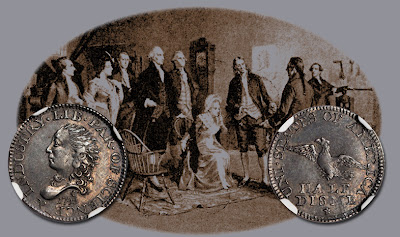
Having just returned home after a busy and exciting week at the March 2012 Whitman Coin & Collectibles Baltimore Expo, I finally have some time to reflect on the success of the Official Auction conducted by Stack’s Bowers Galleries. Bidding was brisk across all series of U.S. coins, indicating continued strength in the rare coin market. With noteworthy prices realized in series as diverse as colonials and territorial gold, focusing on a particularly strong price realized in our March 2012 Baltimore Auction is anything but an easy task. Even so, a casual perusal of our prices realized cannot help but identify the beautiful 1792 half disme in NCG AU-58 as a stand out highlight of our Rarities Night event. The coin realized $212,750 as lot 4051 – a very strong price that reflects the quality of the coin and its historic significance within the pantheon of numismatic rarities.
The 1792 half disme is the first coin issue struck under the authority of the United States Mint. The historical event and reference were described by none other than George Washington who, in his address to Congress on November 6, 1792, identified these coins as a regular coinage of the nation’s Mint. The requisite portion of the president’s address is quoted, as well as elsewhere, in the 1998 book Federal Half Dimes: 1792-1837 by Russell J. Logan and John W. McCloskey:
“In execution of the authority given by the legislature, measures have been taken for engaging some artists from abroad to aid in the establishment of our Mint. Others have been employed at home. Provisions have been made for the requisite buildings, and these are now putting into proper condition for the purposes of the establishment. There has been a small beginning in the coinage of half dismes, the want of small coins in circulation calling the first attention to them.”
Notice the President’s use of the phrase, “now putting into proper condition for the purposes of the establishment,” in relation to the “requisite buildings” for the Mint. The President was correct that, at the time that the 1792 half dismes were struck, the actual Mint buildings were not yet ready for operations. Accordingly, the 1792 half dismes were struck outside of the future Mint building, but probably using Mint equipment and definitely under the authority and supervision of Mint personnel. The actual location where these coins were struck is thought to have been in John Harper’s shop at the corner of Sixth and Cherry streets in Philadelphia. The necessary Mint Act was signed into law on April 2, 1792, and this Act specified the actual weights and fineness of the various coins proposed to be struck. David Rittenhouse was appointed the first director of the Mint by President Washington on July 1, 1792. Things were moving rather quickly at this point, and President Washington himself provided the silver to be melted and refined to the exacting measure of .8924 fine silver with the balance an alloy of copper and trace elements. These initial 1,500 half dismes were delivered to Thomas Jefferson on July 13, 1792 by Mint authorities as noted in Jefferson’s own writings. These half dismes were legal tender and placed into circulation, and are the first significant issue of coins struck by the United States Mint.
Although closely related to the 1792 “proposed coinage” of the United States Mint, and listed among them on pages 84-86 in the 2012 edition of the Guide Book, President Washington’s address clearly establishes the 1792 half disme as a regular issue of the United States Mint. It is the first regular issue U.S. Mint coin, as such, evidence for which also comes from the fact that some 1,500 silver impressions were made – far too high a mintage for a proposed (i.e., pattern) coin. Additionally, the 1792 half disme as an issue clearly circulated, and not only because Washington linked the production of these coins to a need for small change in commercial channels at that time. Most survivors of this issue are worn, some extensively, and it is obvious that many 1792 half dimes spent a considerable amount of time in circulation as coinage of the realm.
In addition to its historical significance as the first regular issue coin struck under authority of the United States Mint, the 1792 half disme enjoys such strong demand among advanced collectors due to a couple of popular stories attached to this issue. The first has it that George Washington himself provided some of his own silverware to be melted down and coined into these half dismes. Another story suggests that the portrait of Liberty used on the obverse of these coins is a likeness of Washington’s wife Martha.
Scarce in an absolute sense and rare from a market availability standpoint, surviving 1792 half dimes usually remain locked away in tightly held collections for long periods of time, where they serve as a cherished keepsake of the earliest days of the United States Mint and, indeed, our nation as a whole. The example recently sold in our March 2012 Baltimore Auction exhibits an uncommonly strong strike for the type with both sides (yes, even the reverse) well centered on the planchet. The devices are bold to sharp in detail, save for in the centers where minimal wear is largely concentrated to explain the AU-58 grade from NGC. Both sides are richly and evenly toned in a charcoal-gray patina. The coin obviously represented a fleeting bidding opportunity for an advanced collector, as indicated by the strong realized price quoted above.





